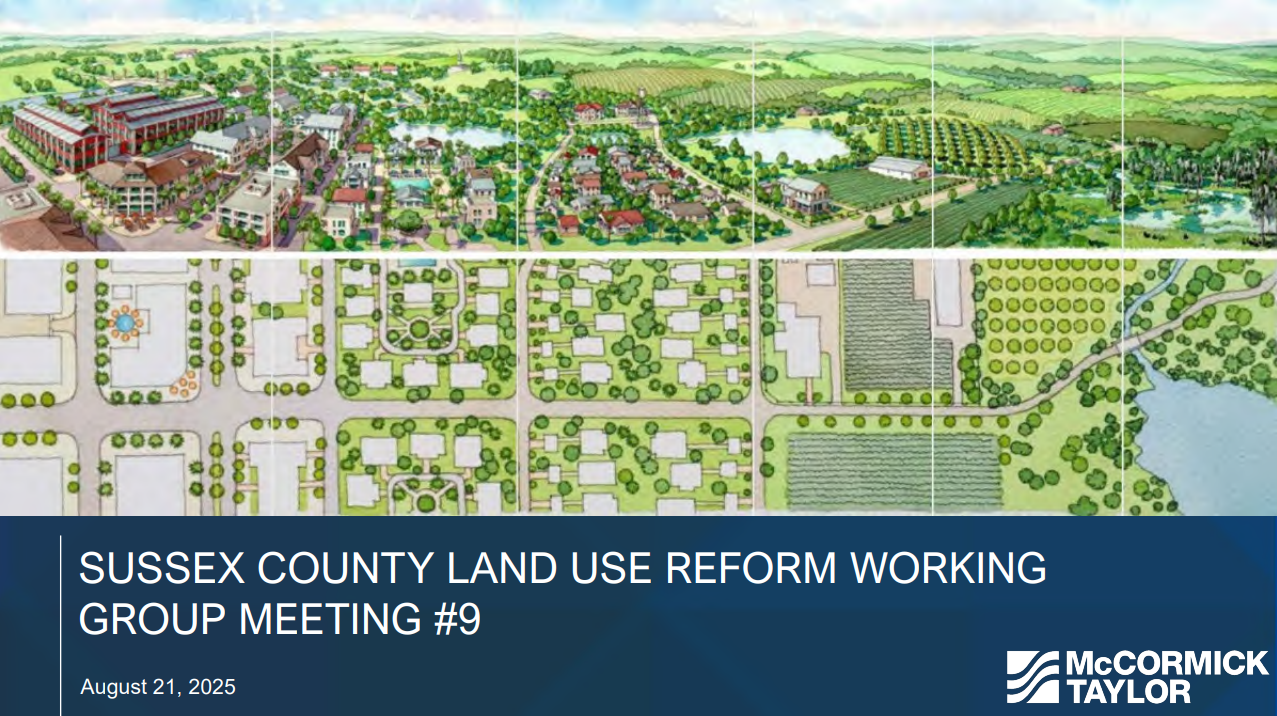The Sussex County Land Use Reform Working Group gathered on August 21st to refine its draft recommendations for county land use policies.
The purpose of this session was to review and finalize 19 draft recommendations, shaped by prior meetings, written feedback, and consultation with county leadership.
The group remains on schedule to present its final draft at the September 11th meeting, when members will vote on each recommendation.
The August 21st meeting revisited recommendations in numerical order, and while some passed with little debate, others sparked more detailed discussions.
Recommendation #1: Future Land Use Map
Recommendation #1 focuses on aligning the county’s future land use map with the state’s strategies for spending as part of the 2028 plan update.
“Align Future Land Use Map: As part of the 2028 Comprehensive Plan Update, revise the Future Land Use Map (FLUM) using the State Strategies for Spending as a guide, where appropriate, to designate the boundaries of the Growth Areas and the Conservation Areas.”
This item would clearly define growth and conservation boundaries, setting the stage for all other reforms.
The group noted no further comments or edits, and the draft recommendation remains unchanged as we move on to the next meeting for potential finalization of the draft list.
Recommendation #2: Growth and Conservation Areas
The second recommendation sparked extensive discussion. It proposes establishing clear growth and conservation areas, with new transition zones along edges of growth areas to gradually reduce density and intensity.
For full language, you can view recommendation #2 here!
Members highlighted that this approach, while often used informally, should be formalized to strengthen predictability and reduce land use conflicts.
Debate centered on how to define arterial roadways, since broad interpretations could encompass much of the county.
Members stressed that infrastructure availability, such as sewer service, should act as a limiting factor.
Terminology also came under review: some argued that “conservation areas” might confuse the public or imply stricter protections than intended, while others defended the label as necessary to preserve farmland and natural resources.
In the end, members agreed that Recommendation #2 provides critical long-term direction, even though refining the details will require a comprehensive plan rewrite and parcel-by-parcel analysis.
Recommendation #3: Comprehensive Rezoning
Recommendation #3 calls for a full countywide rezoning effort, acknowledged as a “big lift” on par with rewriting the comprehensive plan.
“Comprehensive Rezoning: As part of the 2028 Comprehensive Plan Update, undertake a countywide rezoning effort to realign zoning districts with growth and conservation areas established in recommendation #2. The process should prioritize enabling housing diversity and affordability and be supported by public engagement and implementation guidance.”
Members agreed it was necessary to align zoning with land use goals, but they emphasized sequencing and balance.
Suggestions included starting with agricultural and conservation areas to establish protections, then allowing greater density in growth zones to promote affordability.
Representatives from DSHA reminded the group that technical assistance is available and stressed that rezoning should increase market-rate supply to ease pressure on existing housing stock.
Caution was raised against piecemeal rezoning: downzoning without upzoning could worsen shortages, while upzoning without protections could undermine farmland preservation.
The group agreed sequencing will be critical.
Recommendation #4: Rezoning Standards
This recommendation calls for establishing clear standards to ensure consistency and predictability in rezoning.
For full language, you can view recommendation #4 here!
Members offered no changes, and the draft recommendation remains as previously written.
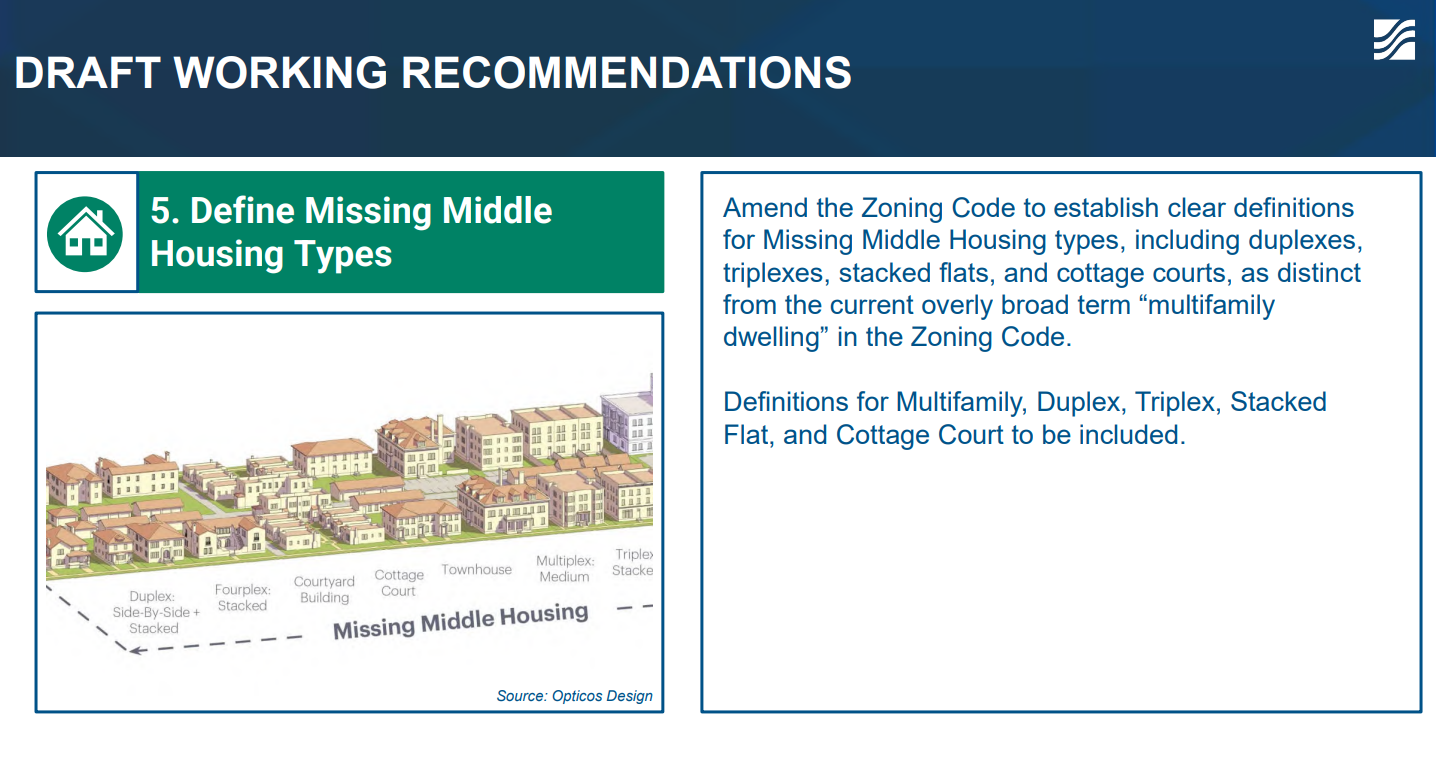
Recommendation #5: Defining Housing Types
Recommendation #5 provides definitions for “missing middle” housing types.
For full language, you can view recommendation #5 here!
Handouts from the prior meeting supplied these definitions, and no changes were proposed, so the draft recommendation stands unchanged.
Recommendation #6: Permitting Missing Middle Housing
Recommendation #6 would allow housing types such as duplexes, triplexes, and townhomes in strategic areas to expand diversity.
For full language, you can view recommendation #6 here!
The discussion focused on ensuring compatibility with density bonus programs.
Members emphasized that when developers use incentives for workforce housing or preservation, they may need flexibility to construct more intensive housing types.
Without such flexibility, bonus density programs could become unworkable.
The group agreed to link Recommendation #6 with Recommendation #9, ensuring the two policies complement one another.
Recommendation #7: Bulk and Setback Standards
This recommendation sets standards such as height, building length, and separation for missing middle housing.
For full language, you can view recommendation #7 here!
While most provisions were accepted, cottage courts were identified as a gap. These small-lot developments (around 3,000 sq. ft. per lot) lack defined setbacks, which could cause issues if platted as individual lots.
Suggested placeholders included 3-foot side setbacks, 10-foot front setbacks, and 15-foot rear setbacks, but the group decided to leave specific numbers for future technical review.
This ensures consistency across housing types while leaving room for refinement.
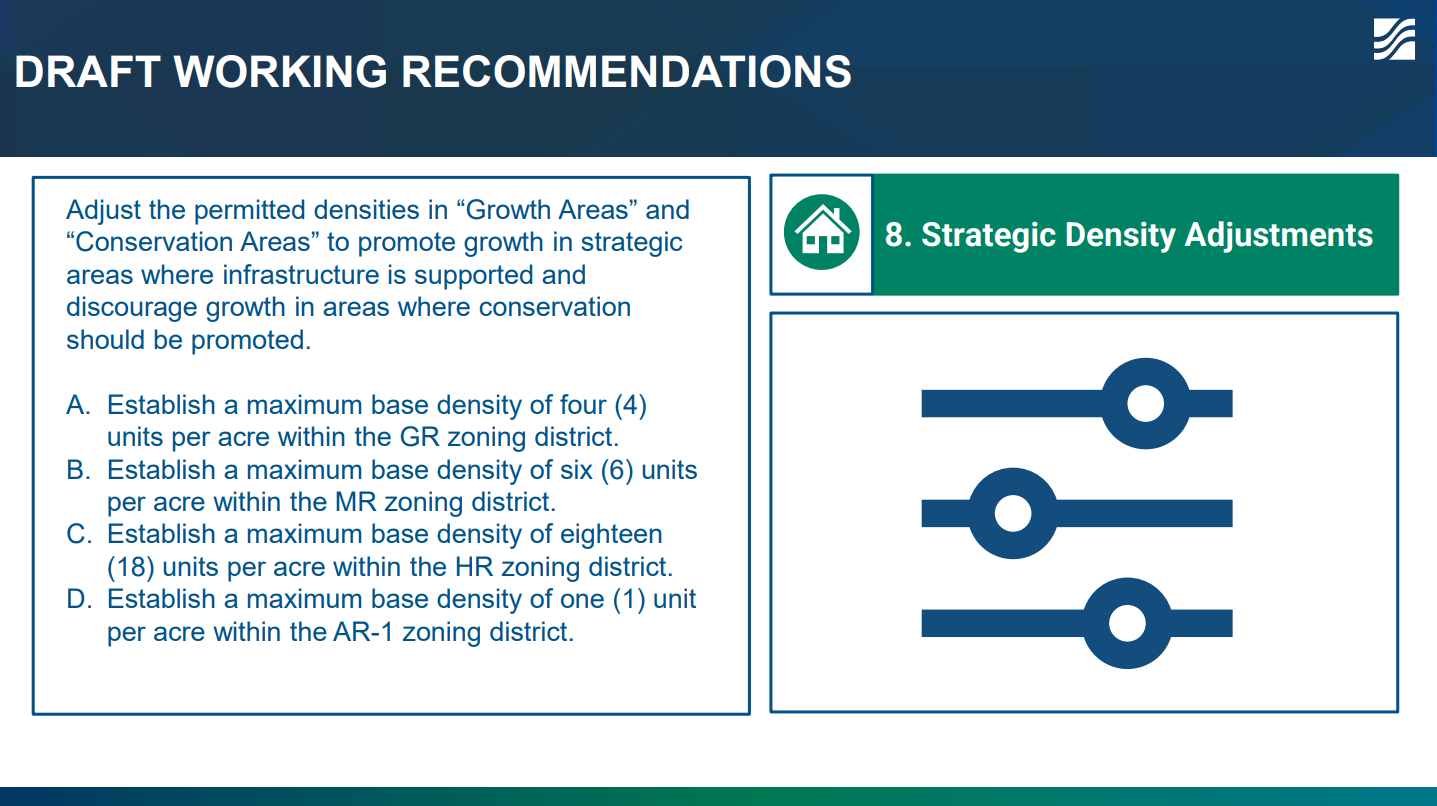
Recommendation #8: Agricultural Zoning and Density
Recommendation #8 generated one of the most emotional debates. The draft proposes reducing AR-1 density from two units per acre to one.
For full language, you can view recommendation #8 here!
A farmer strongly opposed the change, arguing that it amounts to downzoning farmland and stripping farmers of equity they rely on for loans and operational stability. He warned of foreclosures, loss of generational farms, and pressure to sell to developers.
Other working members noted farmland near growth zones has already gained equity due to development pressure, and emphasized the county’s responsibility to direct growth toward areas with infrastructure.
Discussion suggested funding, TDR programs, or compensation mechanisms as ways to offset equity loss.
The group recognized the difficulty of resolving these competing concerns within its scope, and suggested even a separate group to be formed to wrestle with the ideas of this recommendation specifically.
The draft recommendation moves forward unchanged, though the council will need to carefully weigh the financial impact on agriculture against planning goals.
Recommendation #9: Density Bonus Programs
This recommendation promotes strategic density bonus programs to encourage desired development patterns.
For full language, you can view recommendation #9 here!
While acknowledged as a complex area, no changes were made, and the draft recommendation moves forward as written.
Recommendation #10: Affordable Housing Set-Asides
Recommendation #10 addresses the percentage of affordable housing units under the SCRP program and rent limit alignment.
For full language, you can view recommendation #10 here!
Earlier drafts reduced the set-aside from 25% to 10%, but county staff suggested 15%.
Some members argued 10% was too low, while others countered that 15% had failed to produce projects in the past and 10% would be more practical.
The group also agreed to allow flexibility with rent limits, aligning them with HUD or other federal/state programs to accommodate financing options.
I was confirmed that this matched DSHA guidance. The final percentage and rent language will be finalized later.
Recommendation #11: Transportation Improvement Districts (TIDs)
This recommendation requires TIDs in all growth areas and impact fees in both growth and conservation areas.
“Create Transportation Improvement Districts for all Growth Areas and Develop a Transportation Impact Fee for Development in Conservation Areas.”
Members clarified that fees cover design and construction, not long-term maintenance.
Implementing TIDs countywide would be a significant administrative challenge, so coordination with DelDOT and exploring expedited approaches were recommended.
Members emphasized distinguishing between TIDs, area-wide, long-term studies, and impact fees, which provide targeted funding. Conservation area fees would be higher to discourage development there.
The group retained the draft recommendation with added emphasis on coordination and clarity.
Recommendation #12: Master Plan Zoning Overlay
The group confirmed adoption of ZOTA for large-scale development projects.
“Complete adoption of a Master Plan Zoning Ordinance for Large-Scale Development: Complete adoption of the drafted Master Plan Zone ordinance to enable coordinated, mixeduse, and infrastructure-supported developments that align with County goals. This zoning tool can help guide large-scale development through a phased, Comprehensive Plan-aligned process.”
No changes or objections were raised about this recommendation.
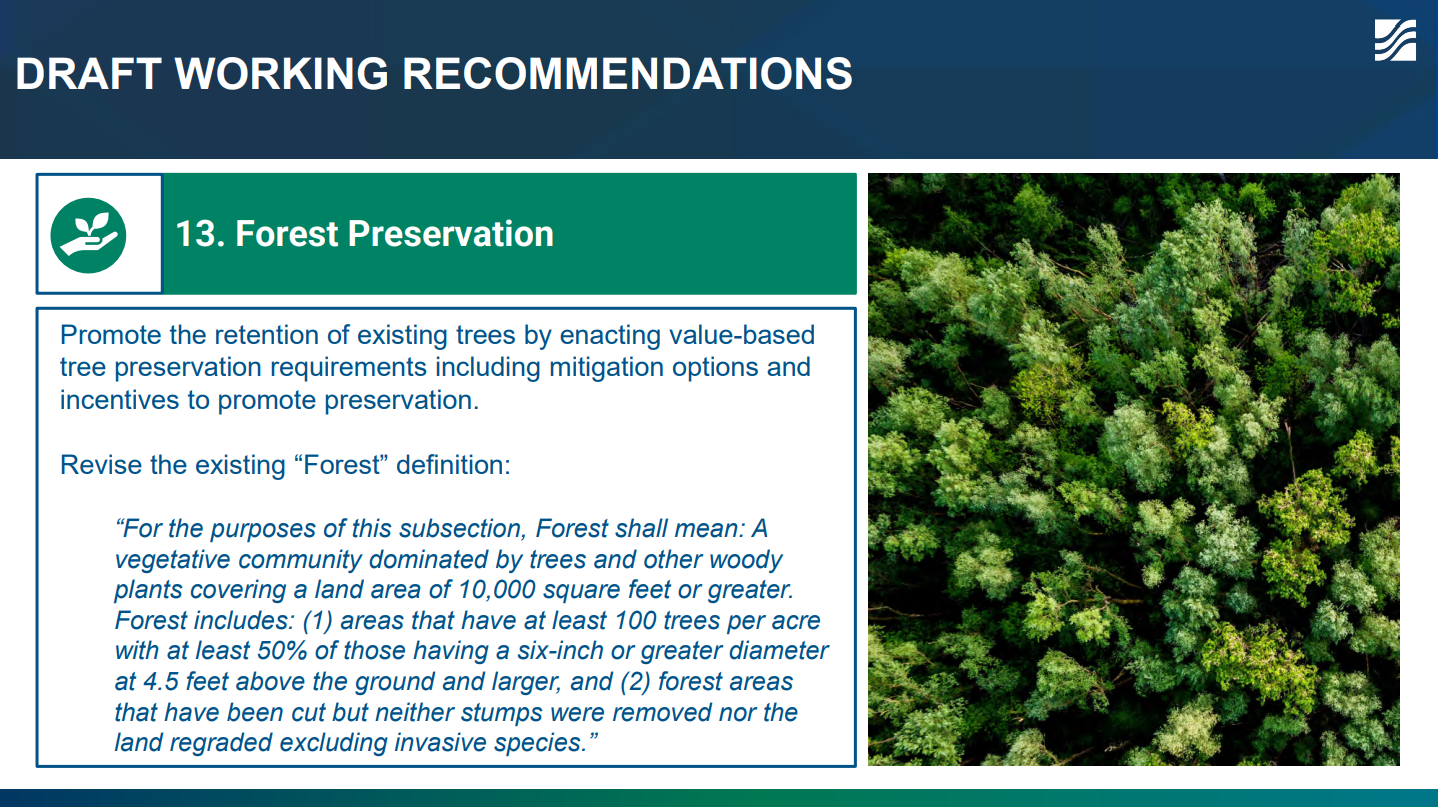
Recommendation #13: Forest Preservation
Recommendation #13 emphasizes preserving mature trees and preventing forest loss.
For full language, you can view recommendation #13 here!
Members debated fee-in-lieu mitigation, with some supporting pooled funds for large-scale preservation through organizations like the Land Trust, and others warning it could incentivize tree removal. Mature trees, they stressed, provide irreplaceable ecological benefits.
For now, the recommendation prioritizes on-site preservation, with openness to further input from the state forestry division.
Recommendation #14: Naturalized Landscaping
This recommendation supports passive open space and naturalized landscaping in new developments.
“Encourage Naturalized Landscaping in Passive Open Space: Encourage naturalized landscaping and native vegetation located within passive open space, where site conditions and regulatory standards permit. The County should coordinate with the Sussex Conservation District to identify opportunities to support habitat-friendly design features, such as native plantings, pollinator zones, and low-mow areas, in preserved open space. This recommendation is intended to support existing trends and complement state standards, not override technical requirements or design constraints.”
No changes or objections were raised, and it was accepted as drafted.
Recommendation #15: Conservation-Focused Subdivision Design
Recommendation #15 promotes subdivision layouts that prioritize conservation, particularly outside growth zones. Members discussed increasing open space requirements to 35–50%.
For full language, you can view recommendation #15 here!
Concerns included infrastructure constraints, such as larger lots for septic and well systems, and the risk of de facto downzoning.
The group emphasized protecting interconnected resources like forests, wetlands, waterways, and wildlife corridors, without ranking them.
Members also noted that fee-in-lieu programs must be carefully structured to avoid incentivizing resource degradation.
The flexible range allows council to decide the final requirement while ensuring conservation remains central to subdivision design.
Recommendation #16: Agricultural Support Uses
This recommendation allows certain ag-support uses by right in AR-1 and conservation zones, rather than requiring public hearings. Examples include equipment dealerships, repair facilities, and processing plants.
“Support Working Farms Through Permitted Agricultural Support Uses: Support the viability of working farms in AR-1 zoning outside designated growth areas by permitting commercial agricultural support uses, such as processing facilities and equipment repair, subject to performance standards. Review and revise outdated zoning procedures (e.g., Board of Adjustment requirements) that may duplicate state oversight.”
One of the members emphasized that past delays have discouraged investment, while other noted parameters such as minimum lot size and adjacency to preserved lands could guide implementation.
A third member supported protections, but agreed language could specify by-right status subject to performance standards.
The group saw this as a way to support the farm economy immediately while leaving room for adjustments in future rezoning.
Recommendation #17: Transfer of Development Rights (TDR)
Recommendation #17 signals support for exploring a TDR program, though no details were developed due to time constraints.
“Explore a Transfer of Development Rights (TDR) Program: Review TDR programs to enable voluntary transfer of development rights from conservation-priority areas to designated growth zones with sending/receiving areas.”
Members emphasized that this is a starting point for council to study feasibility, not a commitment. No changes were made to the draft recommendation.
Recommendation #18: Subdivision Code 99-9C
This recommendation improves clarity and consistency in Subdivision Code 99-9C.
For full language, you can view recommendation #18 here!
No further comments were raised, and the draft recommendation remains unchanged.
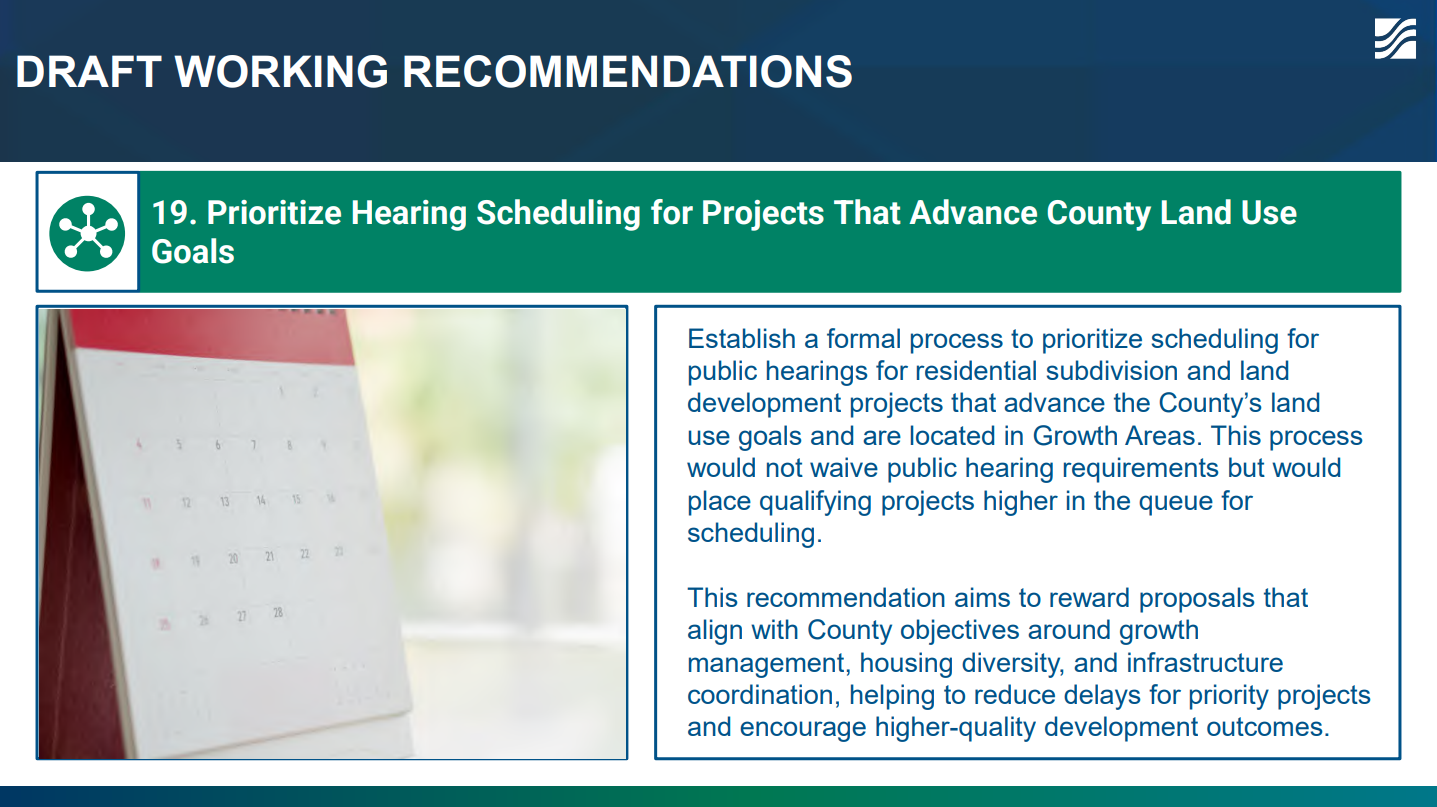
Recommendation #19: Prioritizing Hearings for Land Use Objectives
Recommendation #19 prioritizes scheduling hearings for projects supporting land use goals, with emphasis on affordable housing.
“Prioritize Hearing Scheduling for Projects That Advance County Land Use Goals: Establish a formal process to prioritize scheduling for public hearings for residential subdivision and land development projects that advance the County’s land use goals and are located in Growth Areas. This process would not waive public hearing requirements but would place qualifying projects higher in the queue for scheduling. This recommendation aims to reward proposals that align with County objectives around growth management, housing diversity, and infrastructure coordination, helping to reduce delays for priority projects and encourage higher-quality development outcomes.”
Members argued that by-right projects like Chapel Branch Apartments should not be delayed by additional hearings, and suggested reevaluating conditional use categories to prevent bottlenecks. Public concerns should instead be addressed through code requirements.
The group retained the draft recommendation as written.
Public Comments
During public comment, a fifth-generation local farmer warned that downzoning agricultural land could jeopardize farmers’ equity, financing, and retirement planning.
He also raised workforce challenges, processing facility limitations, and environmental concerns like saltwater intrusion and irrigation restrictions.
A local of Rehoboth Beach suggested reconsidering AR-1 as the county’s default agricultural zone and adopting more tailored categories.
Meeting Conclusion and Next Steps
The meeting ended with an explanation of the September 11th voting process.
Members will use Mentimeter to indicate their level of support across five categories, with results displayed as a heat map. Votes will apply to each recommendation as a whole and will be anonymous.
A member from the Center for the Inland Bays also suggested a vote on the full package to gauge overall consensus could also be beneficial.
They were all reminded to review recommendations in advance and communicate absences.
The August 21st meeting brought the working group closer to finalizing its comprehensive set of land use recommendations.
The September 11th session will determine which proposals move forward with consensus support.
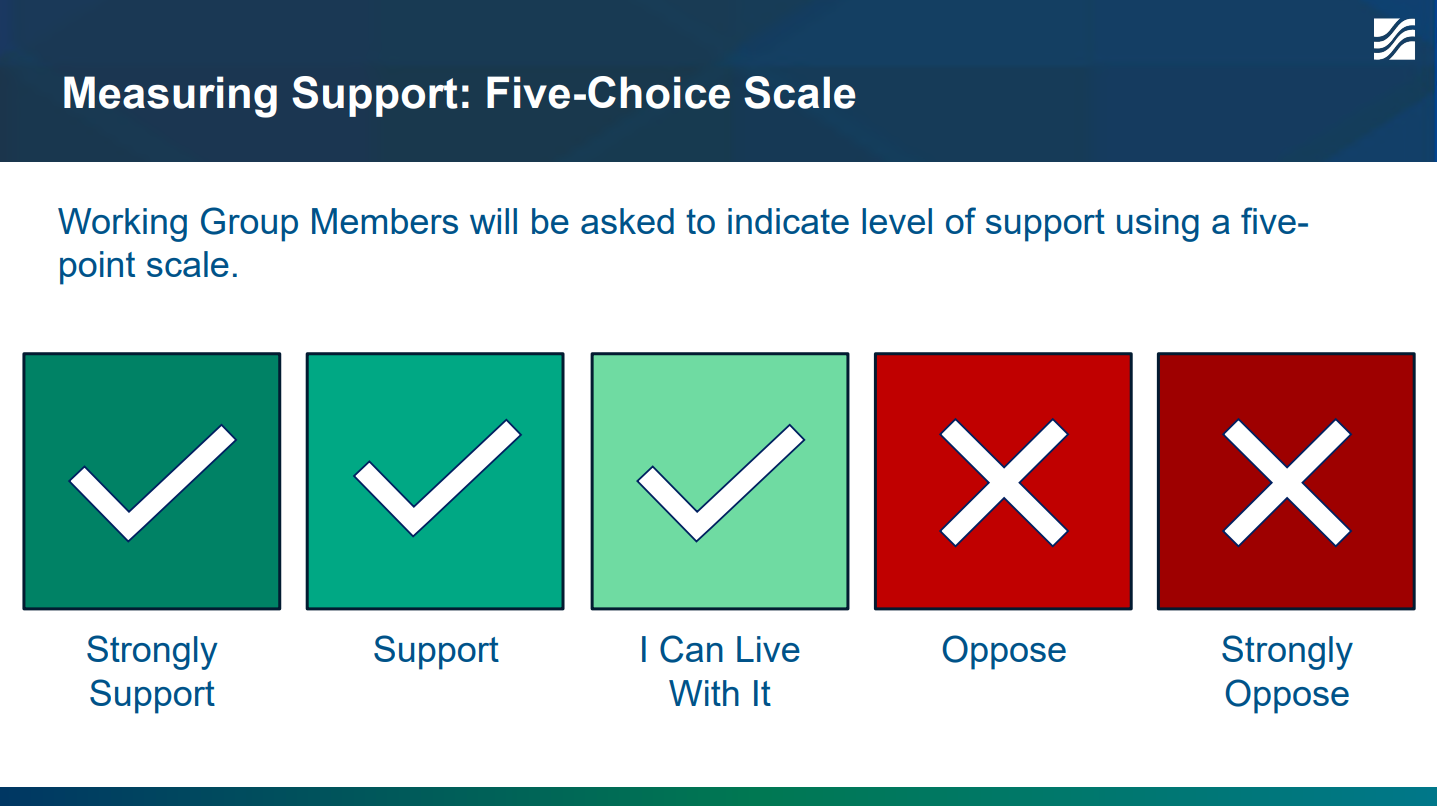
What are your thoughts on the recommendations? Share your perspective in the comments below, and follow our blog for more updates on upcoming meetings and county planning initiatives.
All referenced documents and details from our blog can be found through meeting notes / materials / meeting minutes that are available through Sussex County’s official website, and public meeting minutes & broadcasts archive.
Sources: Land Use Reform Working Group Meeting, Draft Recommendations, Land Use Reform Working Group Presentation

